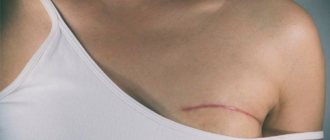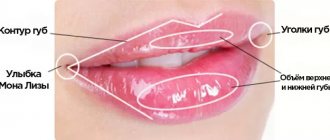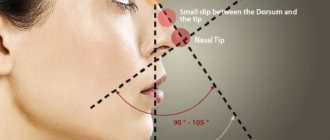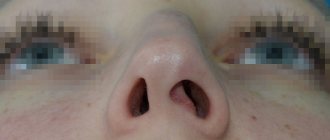Why is an unsuccessful result possible?
The enlargement procedure requires certain knowledge and practical experience of a specialist. In the absence of basic professional fundamentals and insufficient skill of the cosmetologist, the result may be unsuccessful.
What is important for a cosmetologist to know:
- points on the lips for the introduction of a substance for enlargement;
- insertion depth;
- amount of filler.
If a cosmetologist is not competent in these matters, then you should not expect a successful result. There are also several other factors that often lead to negative consequences:
- the cosmetologist ignored direct contraindications to the procedure;
- sanitary and hygienic requirements were not met, insufficient sterility during the manipulation;
- non-compliance by the patient with recommendations for the post-procedure period;
- use of cheap, non-certified materials for augmentation.
How is hyaluronic acid removed from lips?
If there are no contraindications, the cosmetologist uses enzymes to remove hyaluronic acid from tissues. To do this, the drug is injected under the skin. Next, hyaluronidase causes accelerated biodegradation of hyaluronic acid. After some time (a couple of weeks), the lips take on a natural shape. After this, you can repeat the enlargement procedure or abandon this idea.
Watch the video showing the procedure for removing residual hyaluronic acid.
Share with your friends!
Subscribe to our Yandex.Zen channel or Yandex.Messenger
Modern methods of lip augmentation
Modern cosmetology offers a huge selection of procedures that correct the shape of the lips:
- introduction of gels;
- lipofilling;
- threadlifting;
- surgical intervention;
- electroporation.
The use of gels is one of the most popular augmentation methods. It gives quick and fairly long-lasting results. Gels can be biopolymer and biodegradable.
The former help to get a more lasting result. They are synthetic based and therefore biodegrade very slowly. The most popular include: “Dermalife”, “Matridex”, “Matridur”.
But they have significant drawbacks: after several years they can move from the injection area to another area, thereby distorting facial features. This often causes an inflammatory process. In addition, if a woman decides to remove the composition from her lips, it will be very difficult to do so. Even with a successful outcome of the operation, scars are possible.
The latter are considered temporary drugs. They have a natural base - hyaluronic acid, which dissolves after six months or a year. It is part of many human tissues (skin, cartilage, etc.), therefore it is completely biocompatible with the human body and does not cause a rejection reaction. The filler is injected into the skin with a thin syringe, after which it is distributed into the tissues with light massage movements by the cosmetologist. Such gels never move and leave no traces behind. The most popular: Juvederm, Restylane, Perlane.
Among the disadvantages: the need to repeat the manipulation, high cost.
Lipofilling – the patient’s own fat tissue is used as a filler. As with biodegradable gels, there is no rejection reaction. The effect of the procedure lasts much longer. This is because fat cells take root well, are tightly attached to the injection area, and are fed from nearby blood vessels. But a small part of the filler still undergoes resorption. The patient must be ready to accept the result of the procedure, since the modified lips will never look the same again. It is performed under general anesthesia, so it is not suitable for everyone.
Threadlifting involves the introduction of biodegradable mesothreads into the lips. Typically, they are made from polylactic acid, polyglycogel acid or polydioxanone. These materials almost never cause allergic reactions. Modeling the shape of the lips is carried out using thin needles. The threads promote collagen production, create a clear lip contour, and retain the effect for 2-3 years.
Surgery can be performed using several methods:
- Operation Bullhorn. After the incision and lifting of the upper lip, its red border is turned outward, giving the lips a visually larger volume. The incisions are made in the nasolabial fold, so the marks after the operation are invisible.
- VY-plasty. It can be reconstructive and aesthetic. The first involves a complete change in size and shape. Often used for congenital pathologies. The second slightly corrects the shape and adds volume. The essence of the method: several cuts (from 2 to 8), after which the inner part is turned out, all this is secured with a seam that resembles the Latin letter Y.
- Paris. After the incisions, the plastic surgeon everts the inner part of the mucosa in a horizontal and vertical position at the same time.
Electroporation . Under the influence of electrical impulse waves generated by a special apparatus, the tissues of the biolayer lipid membrane are saturated with low molecular weight compounds - hyaluronic acid. The method is suitable for minor shape correction, increasing the overall volume of the lips, and inhibiting the aging process.
Reasons for removing hyaluronic acid from lips
Today, the procedure for “pumping” gel out of lips is becoming increasingly popular. It is carried out by cosmetologists, who name the main reasons why women decide to take this step.
See also...
✅ Eyebrow care regimen to restore thickness and shape to your eyebrows
✅ How to remove a tattoo completely: description of methods
✅ Rhinoplasty: which celebrity changed the shape of their nose?
✅ This makes it easier to keep fit and 4 more reasons why home clothes should be tight-fitting
- An unnatural shape is the first reason that makes you want to get rid of lip fillers. Initially, many people ask a specialist to make lips like Angelina Jolie’s, but over time they realize that they look unnatural with such volume.
- Asymmetry is another popular reason that brings women to cosmetologists to remove hyaluronic acid from their lips. This can be caused by the technician’s inexperience or the patient’s failure to follow recommendations for caring for “new” lips.
- Painful sensations arising from intolerance to the injected drug are the main indicator that the gel needs to be removed.
Inflammatory processes cannot be ignored - it is dangerous to health. They manifest themselves as swelling, redness, itching, purulent accumulations, etc. In such a situation, you should immediately contact a specialist, without hoping that the massage will help the gel to distribute correctly.
The negative consequences described above can lead to:
- inexperience of the master who will puncture blood vessels during the procedure;
- too deep or, on the contrary, superficial introduction of filler;
- violation of sanitary standards during the procedure;
- individual intolerance, which was not previously identified;
- use of uncertified drugs.
To avoid these problems, it is recommended to approach the choice of a specialist with all responsibility, not to be fooled by low prices and promotions, but to trust your face only to proven professionals.
But we should not forget that the desire to remove hyaluronic acid from the lips can be caused by fashion. Today, everything strives for naturalness, so many women who once enlarged their lips now dream of their former natural shape.
What are the consequences for appearance and health after unsuccessful lip augmentation?
The main consequence of an unsuccessful procedure is a cosmetic defect, such as asymmetry. It often occurs when the technique of introducing filler or performing surgery is incorrect. And also if the patient decides to enlarge her lips with biopolymer gels. Over time, the composition can migrate in the other direction, distort the contour of the lips and even create the effect of a hole or dip in the injection area.
An unqualified practicing cosmetologist or new to the field of corrective cosmetic procedures may introduce an excessive amount of filler. As a result of such actions, the effect of “duck lips” is possible. It looks extremely unattractive and spoils the natural beauty. It is also possible to form nodes that are a consequence of a granulomatous or local inflammatory reaction to a foreign body.
Lip augmentation can have more than just cosmetic consequences. Various medical complications are possible.
For example, the proliferation of fibrous tissue, which leads to compaction in the lips. As a result, a woman may experience problems with speech and nutrition.
One of the most serious negative consequences of contouring is neurological complications. They can occur if the facial nerve is damaged during the procedure. Infection and bacterial infection are also possible, resulting in inflammation and suppuration.
What to do if your lips were done unsuccessfully?
If your lips have been done unsuccessfully, you should definitely contact several doctors: cosmetologists, surgeons, and get a comprehensive consultation on how to further solve the problem.
You can correct asymmetry or “duck lips” in several ways, depending on the characteristics and location of the problem:
- Specific drug therapy aimed at improving metabolism and blood flow in tissues.
- Contour plastic surgery by a more experienced specialist (introduction of absorbable biothreads along the contour, correction with fillers, surgery).
When nodes form , massage is necessary, as well as corticosteroid injections. However, the nodes may be resistant to such methods of corrective therapy, so sometimes a more radical method of solving the problem is necessary: puncture and aspiration of the contents, surgical excision.
The severity of fibrosis (i.e. hard lips) can be reduced with the help of special medications that promote tissue resorption. But the problem can only be completely eliminated through surgery.
The infection is treated with systemic and local antibiotics. The dosage and specific drug should be chosen only by the doctor, taking into account contraindications and the presence of allergic reactions in the patient.
If the facial nerve was affected , then the patient will need a thorough diagnosis (MRI, radiography, electromyography, etc.) to determine further treatment tactics. It usually includes taking anti-inflammatory drugs, antispasmodics, painkillers, glucocorticoids, and vasodilators. As well as physiotherapy (electrophoresis, acupuncture, ultrasound, massage, etc.).
If complete recovery does not occur, biostimulants and hyaluronidase are added. If a rupture occurs, suturing or neurolysis is necessary.
Description of the biopolymer gel removal technique
Removal of the biopolymer is performed surgically, usually under local anesthesia. The doctor makes a neat incision on the inner surface of the lip using a scalpel. The incision itself will not be visible on the lips in the future.
After making an incision from the tissue, the gelomas are gradually removed. Please note that it is not always possible to completely remove the biopolymer gel at one time. The reason is the ability of the biopolymer gel to grow into tissues and migrate. That is why the doctor warns the patient that repeated intervention may be required over time. If necessary, lip shape correction is performed during surgery to restore the disturbed harmony of proportions.
Not all surgeons undertake biopolymer excision. This is a very delicate and painstaking work that should only be performed by an experienced plastic surgeon.
3 ways to prevent unsuccessful lip augmentation
- Before deciding on the procedure, the patient must make sure that the filler product is certified, and also that the cosmetology center has qualified, experienced staff.
- You must make sure there are no contraindications and follow all the specialist’s recommendations before and after the procedure!
- The consequences may appear a year after the procedure, so you need to consult a plastic surgeon at least once six months.
conclusions
All the information provided above will help minimize the risks of unsuccessful lip augmentation . It is also worth knowing that depending on the specific method and the amount of filler, recovery of the body can last from 1 week to 2 months. At the same time, the first day is considered the most difficult, when the lips swell, turn red, and pain sensitivity appears - such consequences cannot be prevented in any way, since this is a normal reaction of the body to external intervention.
Was the article helpful?










